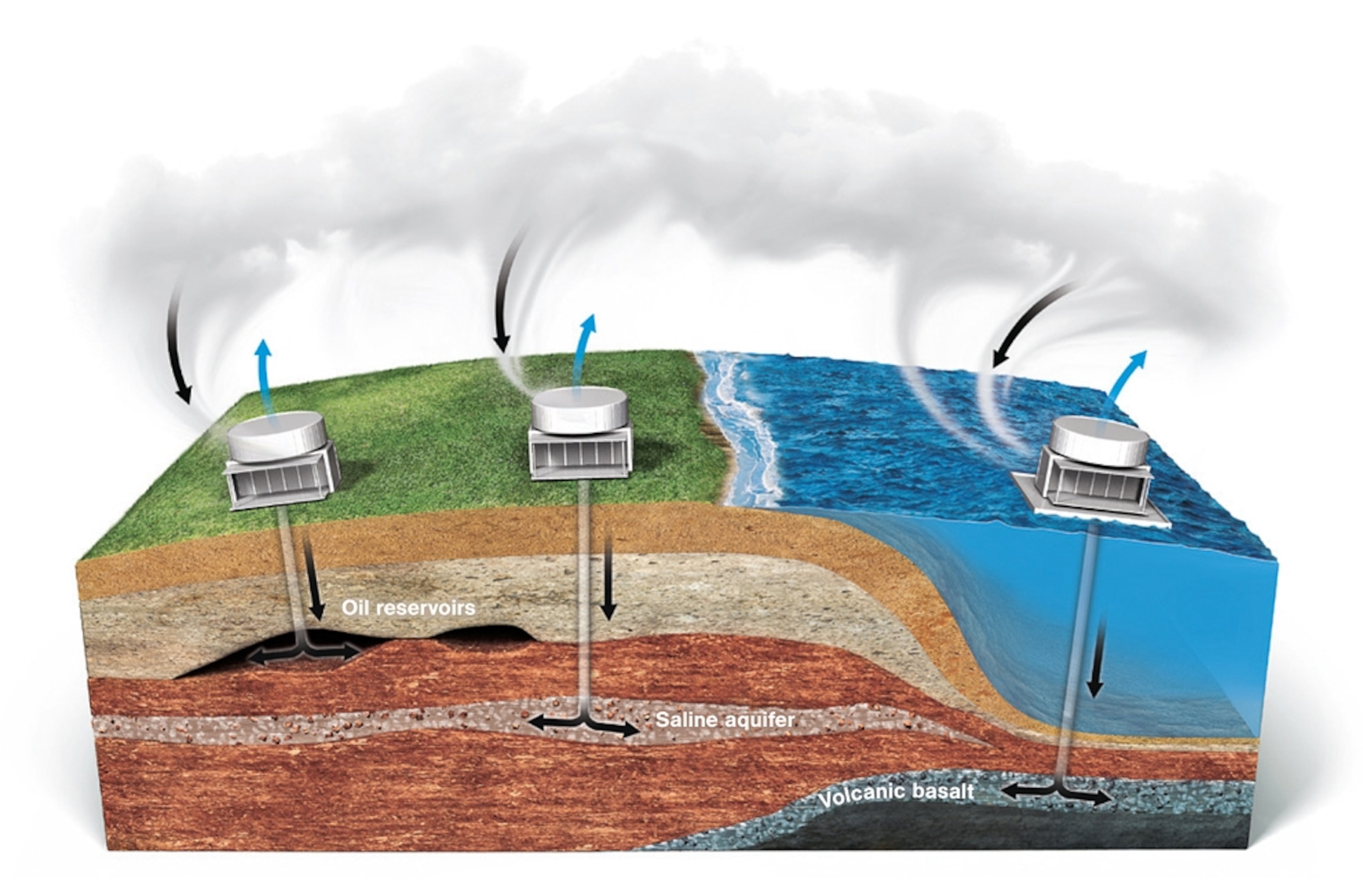
Out of Thin Air: The Quest to Capture Carbon Dioxide
A new report casts doubt on the viability of carbon dioxide "air capture," but entrepreneurial scientists are moving forward with technology to scrub the atmosphere.
Trees and other green plants pull carbon dioxide out of the air. Shouldn't we be able to do it, too? Only better?
A small but determined number of researchers have been working on just this idea: Drawing carbon dioxide directly out of the air with chemicals. They argue it is necessary to help address the huge overburden of greenhouses gases in the atmosphere, a problem that would otherwise continue to compromise the health of the planet even if the world stopped burning fossil fuels tomorrow.
The advocates of "direct air capture," however, seemingly were dealt a blow when a two-year study released in June by a committee of the American Physical Society (APS) cast doubt on whether the technology could ever be cost-effective. Relying on data in the public domain, the APS panel expressed pessimism about the technology's prospects, at least in the short term.
Undaunted, air capture researchers are continuing their work toward demonstration of the technology and commercialization. They say that their own findings, some of which are not yet published, give them reason to be optimistic. And they say their technologies could be combined with others or used in applications that could offset costs. For example, direct air capture might prove especially well-suited to recycle carbon dioxide back into the ordinary, familiar liquid hydrocarbon fuels that power today's trucks, planes, and even cars. (See related story: "Carbon Recycling: Mining the Air for Fuel")
A Dilute Mixture
The concentration of CO2 in the atmosphere is high enough to cause grave risk for the planet, but it is still far more dilute than the CO2 streaming from a power plant smokestack. That dilute mix is the underlying problem with air capture, in the view of the APS panel, co-chaired by Robert Socolow, professor of mechanical and aerospace engineering at Princeton University, and Michael Desmond, an adviser in BP Refining and Marketing's research and technology department.
The committee estimated the cost of direct air capture with chemicals at $600 per ton of CO2, seven times more expensive than proposed technologies to remove CO2 from a coal plant smokestack. At some point, it might make sense to try direct air capture to grapple with the problem of CO2 emissions from "distributed emissions" (such as those from planes, trucks, and cars), the panel said. But it wouldn't make sense to try to capture CO2 from the air until CO2 was already being captured from concentrated sources.
"Human beings may wish to cancel some or all future fossil fuel emissions and even to undo past emissions," wrote the APS committee. "But wishing is not doing."
The committee specified that it looked only at the cost of CO2 capture; post-capture management of CO2 was beyond the scope of its study. But some researchers note that what is done with the CO2 after it is captured could have bearing on the cost of the whole system.
"If your purpose is to make a fuel, you could capture CO2 right at the point where you convert it," explains Ellen Stechel, manager of the "Sunshine to Petrol" project at the U.S. Department of Energy's Sandia National Laboratories in Albuquerque, New Mexico, and Livermore, California. "You avoid the transportation. You avoid the energy to compress it. And it's going to come out of the air much cleaner than it would" from a flue stack.
Traditional carbon capture and sequestration projects have looked only at burying the CO2 waste, Stechel notes, not using it. But if your purpose is to use the CO2, "then all these advantages plus others might counteract the one disadvantage of air capture—the lower concentration."
Super-Absorbing "Trees"
Klaus Lackner, a physicist at Columbia University, one of the pioneers of research into direct air capture, recently defended the technology in a post on Columbia's Earth Institute blog, "Yes, We Can Afford to Remove Carbon from Air." (Lackner is director of the institute's Lenfest Center for Sustainable Energy.) Lackner noted that the APS report, despite its grim cost analysis, recognized that air capture is one of the few options for reducing atmospheric CO2.
He also said the APS panel did not raise any scientific or technical issues that would preclude the kind of improvements needed to bring the price down. Lackner's own estimate is that the cost of the process he and his team have developed could be brought down to $30 per ton.
Lackner and his colleagues are known for their work on synthetic "trees" (actually, towers) with materials called "sorbents" that would absorb CO2 from the air. The machines would be far more efficient at doing the job than natural foliage— able to extract 1,000 times more CO2 than a tree of the same size. (For a look at Lackner's technology, see "The Big Idea: Scrubbing the Skies.")
The process does require energy, but Lackner says the CO2 captured in their process would exceed the CO2 released—even if the source of energy is the current makeup of the U.S. electricity grid (50 percent coal and 20 percent natural gas). (The amount released in that case would be about 20 percent of what is captured, Lackner says.) The benefits would increase if renewable energy were used.
There is a natural resource cost; water is needed to activate the process of the sorbent absorbing and releasing CO2. "Rather than heating the material, we make it moist," says Lackner. "For us, in a roundabout way, the water acts as a fuel." But Lackner says his team's synthetic trees would use about 100 times less water than ordinary trees.
Lackner's team is now working with San Francisco start-up Kilimanjaro Energy on demonstration plants. He, like Stechel, believes that how the CO2 is used after capture is crucial to consider when assessing the cost of the system. One strategy for addressing costs in the short-term, he notes, is to market the CO2 captured—sharing a location, for instance, with a greenhouse that would value a stream of low-concentration CO2.
"What I've found intriguing about these technologies is they can start before you have a consensus on climate change," Lackner says.
Turning Down the Heat
Two other Columbia University professors who have been working separately from Lackner's group, Peter Eisenberger and Graciela Chichilnisky, also are focused on sieve-like sorbents as a means for extracting CO2 from air.
They say their company, Global Thermostat (GT), uses proprietary sorbents that can capture carbon at substantially less cost and with less energy use than scientists have previously assumed. They say this has been confirmed by outside scientists with leading industrial gas and analytical firms who have produced confidential reports on their process. Chichilnisky and Eisenberger say they offered APS committee access to their experimental data, but the panel declined.
To look at the not-yet-published, commercially sensitive data, the panelists would have had to agree to confidentiality. "As a matter of policy the Committee sought to avoid learning any of their ideas that could not be made public," the panel's report explained.
But Chichilnisky and Eisenberger have explained publicly what they say is an important fact when assessing the cost of their technology: It requires only low-grade heat of less than 212°F (100°C)—the boiling point of water—to do capture CO2. So GT can use the residual heat at any industrial process plant. "Anything that generates heat as part of power is ideal candidate for us to cogenerate with," Eisenberger says. So GT's technology could be located at an ordinary power planet, not for the purpose of absorbing CO2 from the flue gas but to make use of the facility's heat.
Eisenberger and Chichilnisky say GT overcomes the issue that has bedeviled efforts to capture CO2 from the flue gas of coal plants with sorbents—the "parasitic load" problem, or the fact that the extra energy it takes to capture carbon would reduce the efficiency of the coal plant. Chichilnisky says GT's process design, in which residual heat is the main source of energy, is key to lowering costs, since such low heat is inexpensive or even free.
"There is enough residual heat in a coal power plant to capture twice as much carbon as the plant emits," she says. "This way Global Thermostat can turn a fossil fuel plant into a carbon sink that reduces atmospheric carbon—namely, a carbon-negative power plant. The more energy plants of this type that you produce, the more you clean the atmosphere."
A GT demonstration plant opened last fall at the facilities of the research institute SRI International in Menlo Park, California, is currently is absorbing 700 tons of CO2 per year—about the amount emitted by burning 77,160 gallons (292,080 liters) of gasoline. GT also is working on developing a biorefinery with an algae-based biofuel start-up company, Algae Systems. The CO2 sequestered by Global Thermostat's process could be fed to algae to produce renewable jet fuel, diesel fuel, and biochar (a charcoal created from biomass). GT and Algae Systems are planning joint plants in Japan and India. GT is also developing a plant that aims to take carbon from air and mix it with hydrogen separated from water to produce hydrocarbon fuel in a process the scientists say would be both cost-efficient and renewable.
Draining the Carbon Bathtub
The APS committee said that there was much uncertainty in trying to estimate the viability of capturing carbon from air. "The reality is that neither [direct air capture] costs nor the costs of alternatives are known well today: much depends on the progress of future technology, environmental impacts, and public acceptance," the panel said.
The entrepreneurs stress that costs come down as technology advances. But the APS scientists noted that the reverse also could be true: "Industry experience suggests that cost estimates for any system rise after the completion of pilot plant operations, when the necessary compromises in materials choices, process conditions, component efficiencies, and component lifetimes are taken into account."
Yet the scientists who are committed to developing air capture of carbon believe that society won't be able to tackle the problem of climate change without it. The global climate crisis has long been the focus of Eisenberger, a physicist who is founder of the Earth Institute at Columbia University and of the Materials Institute at Princeton University, and Chichilnisky, a mathematician and economist whose résumé includes that she was the architect of the Kyoto Protocol's carbon market.
"We have envisioned our technology from the beginning as a way to help make the transition one energy ecology system to another," says Chichilnisky.
They are among the many scientists who view the Earth's atmosphere as a bathtub that is filling up with carbon dioxide faster than it can be drained by plants, oceans, and other natural absorption. (See graphic: The Carbon Bathtub) Carbon-negative technology, says Eisenberger, "is the equivalent of taking it out of the drain."
Technologies like carbon-free renewable energy are essential, but insufficient, in the view of Eisenberger and Chichilnisky. "It is too late to just reduce the growth of carbon emissions by building renewable power plants," says Chichilnisky. "There is a $55 trillion fossil fuel energy infrastructure to be replaced, and the process is bound to be slow. The concentration of CO2 is already too high, and the carbon keeps accumulating, so now we need to actually capture and reduce the carbon that is already in the atmosphere."
The APS panel agrees that CO2 levels have grown unacceptably high. The committee took pains to warn policymakers not to delay to address the greenhouse gas problem in hopes that technology would come to the rescue. "This report provides no support for arguments in favor of procrastination in dealing with climate change that are based on the imminent availability of [direct air capture] as a compensating strategy," it said.
But the entrepreneurial scientists working on direct air capture argue that their work is meant to propel climate policy, not postpone it. In the coming years, they aim to show—depite skepticism—that the brimming carbon dioxide bathtub can be drained.
This story is part of a special series that explores energy issues. For more, visit The Great Energy Challenge.








